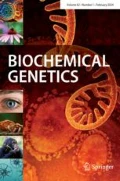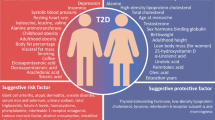Abstract
The purpose of this study was to scan variants in coding region of Krȕppel like factor14 (KLF14) locus and assess association related to type 2 diabetes (T2D) in Iranian population. We sequenced the coding region of KLF14 to scan variants in case–sibling study (92 individuals with T2D and 92 healthy older siblings). To confirm, we analyzed rs76603546 association with T2D in a larger unrelated case–control study by PCR–RFLP (475 cases and 512 controls). We analyzed the association of rs76603546 with HbA1C, BMI, fat mass, waist circumference, fasting glucose, cholesterol and HOMA-IR (Homeostatic Model Assessment for Insulin Resistance) using one-way ANOVA analysis. Also, association of genotypes with T2D adjusted for confounding variables was analyzed using logistic regression. HaploReg v 4.1 was used to predict rs76603546 possible function. Sequencing results analysis revealed the association of C allele of rs76603546, synonymous variant C>T, [OR 2.10 (1.38–3.20), P value < 0.001] and CC genotype of rs76603546 [OR 4.3 (1.79–10.23), P value = 0.001] with susceptibility to T2D. PCR-Restriction Fragment Length Polymorphism (RFLP) results analysis confirmed the association of rs76603546 with T2D [C allele, OR 1.91 (1.59–2.29), P value = 0.002, CC genotype, OR 3.27 (2.26–4.73), P value = 0.002 and TC genotype, OR 1.74 (1.31–2.31), P value = 0.001]. The CC genotype of rs76603546 is associated with HbA1C level (P value < 0.001) and BMI (P value = 0.02). After adjustment with confounding variables, we observed association of CC genotype with T2D [OR 2.542 (1.25–3.77), P value = 0.03]. Among over 220 SNPs, rs76603546 was associated with T2D, HbA1C and BMI in our study.
Similar content being viewed by others
Data Availability
All authors ensure that all data and materials as well as software application or custom code support their published claims and comply with field standards.
References
Abbasi-Shavazi MJ, McDonald P, Hosseini-Chavoshi M (2008) Modernization or cultural maintenance: the practice of consanguineous marriage in Iran. J Biosoc Sci 40:911–933
Alves JGB, Figueiroa JN, Meneses J, Alves GV (2012) Breastfeeding protects against type 1 diabetes mellitus: a case–sibling study. Breastfeeding Medicine 7:25–28
Bush WS, Moore JH (2012) Genome-wide association studies. PLoS Comput Biol 8:e1002822
Civelek M, Lusis AJ (2011) Conducting the metabolic syndrome orchestra. Nat Genet 43:506
Consortium M (2011) Identification of an imprinted master trans regulator at the KLF14 locus related to multiple metabolic phenotypes. Nat Genet 43:561–564
De Assuncao TM et al (2014) New role for Kruppel-like factor 14 as a transcriptional activator involved in the generation of signaling lipids. J Biol Chem 289:15798–15809
Duan J, Wainwright MS, Comeron JM, Saitou N, Sanders AR, Gelernter J, Gejman PV (2003) Synonymous mutations in the human dopamine receptor D2 (DRD2) affect mRNA stability and synthesis of the receptor. Hum Mol Genet 12:205–216
Epstein MP et al (2015) A statistical approach for rare-variant association testing in affected sibships. The American Journal of Human Genetics 96:543–554
Franklin CS et al (2010) The TCF7L2 diabetes risk variant is associated with HbA1C levels: a genome-wide association meta-analysis. Ann Hum Genet 74:471–478
Gonzalez C, Vallcaneras S, Calandra R, Calvar SG (2013) Involvement of KLF14 and egr-1 in the TGF-beta1 action on Leydig cell proliferation. Cytokine 61:670–675
Genotype-Tissue Expression (GTEx) (2020) www.gtexportal.org/home/?geneId=KLF14
Guo Y et al (2015) Perhexiline activates KLF14 and reduces atherosclerosis by modulating ApoA-I production. J Clin Investig 125:3819
Hachiya T et al (2017) Genome-wide meta-analysis in Japanese populations identifies novel variants at the TMC6–TMC8 and SIX3–SIX2 loci associated with HbA 1c. Sci Rep 7:16147
Hoggart CJ, Parra EJ, Shriver MD, Bonilla C, Kittles RA, Clayton DG, McKeigue PM (2003) Control of confounding of genetic associations in stratified populations. Am J Hum Genet 72:1492–1504
Huang P et al (2013) Association of the KLF14 rs4731702 SNP and serum lipid levels in the Guangxi Mulao and Han populations. Biomed Res Int 2013:231515
IFD (2019) IDF diabetes atlas, 9th edn. International Diabetes Federation, Brussels
Irvine RA, Lin IG, Hsieh C-L (2002) DNA methylation has a local effect on transcription and histone acetylation. Mol Cell Biol 22:6689–6696
Kanazawa A et al (2005) Single nucleotide polymorphisms in the gene encoding Krüppel-like factor 7 are associated with type 2 diabetes. Diabetologia 48:1315–1322
Katz A, Nambi SS, Mather K, Baron AD, Follmann DA, Sullivan G, Quon MJ (2000) Quantitative insulin sensitivity check index: a simple, accurate method for assessing insulin sensitivity in humans. J Clin Endocrinol Metab 85:2402–2410
Kolahdouz P, Yazd EF, Tajamolian M, Manaviat MR, Sheikhha MH (2015) The rs3917779 polymorphism of P-selectin’s significant association with proliferative diabetic retinopathy in Yazd, Iran. Graefe’s Arch Clin Exp Ophthalmol 253:1967–1972
Kowalski GM, Carey AL, Selathurai A, Kingwell BA, Bruce CR (2013) Plasma sphingosine-1-phosphate is elevated in obesity. PLoS ONE 8:e72449
Lotfi MH, Saadati H, Afzali M (2013) Prevalence of diabetes in people aged≥ 30 years: the results of screen-ing program of Yazd Province, Iran, in 2012. J Res Health Sci 14:88–92
Mao Y, Liu H, Liu Y, Tao S (2014) Deciphering the rules by which dynamics of mRNA secondary structure affect translation efficiency in Saccharomyces cerevisiae. Nucleic Acids Res 42:4813–4822
Mita K, Ichimura S, Zama M, James TC (1988) Specifie codon usage pattern and its implications on the secondary structure of silk fibroin mRNA. J Mol Biol 203:917–925
Nackley AG et al (2006) Human catechol-O-methyltransferase haplotypes modulate protein expression by altering mRNA secondary structure. Science 314:1930–1933
Nica AC, Dermitzakis ET (2013) Expression quantitative trait loci: present and future. Philos Trans R Soc B 368:20120362
Parker-Katiraee L et al (2007) Identification of the imprinted KLF14 transcription factor undergoing human-specific accelerated evolution. PLoS Genet 3:e65
Rees S et al (2011) Replication of 13 genome-wide association (GWA)-validated risk variants for type 2 diabetes in Pakistani populations. Diabetologia 54:1368–1374
Rifai N (1986) Lipoproteins and apolipoproteins. Composition, metabolism, and association with coronary heart disease. Arch Pathol Lab Med 110:694–701
Sarmento OF et al (2015) A novel role for Kruppel-like Factor 14 (KLF14) in T-regulatory cell differentiation CMGH. Cell Mol Gastroenterol Hepatol 1:188–202
Saxena R et al (2013) Genome-wide association study identifies a novel locus contributing to type 2 diabetes susceptibility in Sikhs of Punjabi origin from India. Diabetes 62:1746–1755
Siren R, Eriksson JG, Vanhanen H (2012) Waist circumference a good indicator of future risk for type 2 diabetes and cardiovascular disease. BMC Public Health 12:631. https://doi.org/10.1186/1471-2458-12-631
Sladek R, Prokopenko I (2016) Genome-wide association studies of type 2 diabetes. In: Barroso J (ed) The genetics of type 2 diabetes and related traits. Springer, New York, pp 13–61
Small KS et al (2011) Identification of an imprinted master trans regulator at the KLF14 locus related to multiple metabolic phenotypes. Nat Genet 43:561–564
Thomas DC, Witte JS (2002) Point: population stratification: a problem for case-control studies of candidate-gene associations? Cancer Epidemiol Prev Biomark 11:505–512
Truty MJ, Lomberk G, Fernandez-Zapico ME, Urrutia R (2009) Silencing of the transforming growth factor-β (TGFβ) receptor II by Krüppel-like factor 14 underscores the importance of a negative feedback mechanism in TGFβ signaling. J Biol Chem 284:6291–6300
Tsui S, Dai W, Lu L (2014) CCCTC-binding factor mediates effects of glucose on beta cell survival. Cell Prolif 47:28–37
Turnpenny PD, Ellard S (2011) Emery’s elements of medical genetics. Elsevier, London
Virtanen KA et al (2005) Increased fat mass compensates for insulin resistance in abdominal obesity and type 2 diabetes: a positron-emitting tomography study. Diabetes 54:2720–2726
Vizcaíno JA et al (2016) 2016 update of the PRIDE database and its related tools. Nucleic Acids Res 44:D447–D456
Voight BF et al (2010) Twelve type 2 diabetes susceptibility loci identified through large-scale association analysis. Nat Genet 42:579–589
Wang J et al (2014) Association of KCNQ1 and KLF14 polymorphisms and risk of type 2 diabetes mellitus: a global meta-analysis. Hum Immunol 75:342–347
Wang N et al (2018) Long noncoding RNA Meg3 regulates mafa expression in mouse beta cells by inactivating Rad21, Smc3 or Sin3α. Cell Physiol Biochem 45:2031–2043
Wei X et al (2017) A novel role for the Krüppel-like factor 14 on macrophage inflammatory response and atherosclerosis development. Cardiovasc Pathol 27:1–8
World Health Organization (2011) Use of glycated haemoglobin (HbA1c) in diagnosis of diabetes mellitus: abbreviated report of a WHO consultation. World Health Organization, Geneva
Wu C et al (2008) Gene set enrichment in eQTL data identifies novel annotations and pathway regulators. PLoS Genet 4:e1000070
Wu J et al (2019) Egr-1 transcriptionally activates protein phosphatase PTP1B to facilitate hyperinsulinemia-induced insulin resistance in the liver in type 2 diabetes. FEBS Lett 593:3054–3063
Acknowledgements
The authors wish to thank Dr. M. Rahmanian and Dr. MH. Sheikhha for technical assistance, Yazd Diabetes Research Center for providing individuals with T2D information, and Mr. Tabatabai for sample collection.
Funding
This work was supported by the Shahid Sadoughi University of Medical Sciences Research Council [Grant Numbers 268471] and the ROJETechnologies Foundation [Grant Number R017-3251/2015].
Author information
Authors and Affiliations
Corresponding author
Ethics declarations
Conflict of interest
There is no conflict of interest to declare.
Ethics Approval
This study was performed in line with the principles of the Declaration of Helsinki. Approval was granted by the Ethics Committee of Shahid Sadoughi University of Medical Sciences (2016/268471).
Informed Consent
Written informed consent was obtained from all participants included in the study.
Additional information
Publisher's Note
Springer Nature remains neutral with regard to jurisdictional claims in published maps and institutional affiliations.
Electronic supplementary material
Below is the link to the electronic supplementary material.
10528_2020_10015_MOESM1_ESM.pdf
PCR-RFLP genotyping of rs76603546 in the KLF14 gene with restriction enzyme MspI. Three SNP genotypes, C/C, C/T and T/T, were detected. M: 100 bp DNA ladder. Identification of three genotypes at +336 position (rs76603546) using Automated Sanger Sequencing Method. CC genotype (a), TC genotype (b) and TT genotype (c) (PDF 124 kb)
Rights and permissions
About this article
Cite this article
Shahvazian, E., Mahmoudi, M.B., Farashahi Yazd, E. et al. The KLF14 Variant is Associated with Type 2 Diabetes and HbA1C Level. Biochem Genet 59, 574–588 (2021). https://doi.org/10.1007/s10528-020-10015-w
Received:
Accepted:
Published:
Issue Date:
DOI: https://doi.org/10.1007/s10528-020-10015-w




